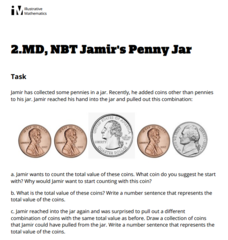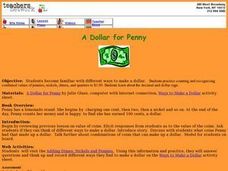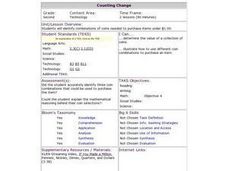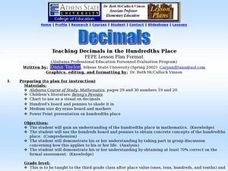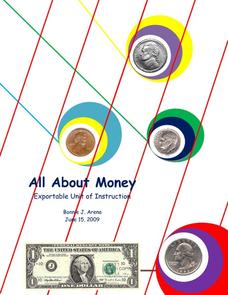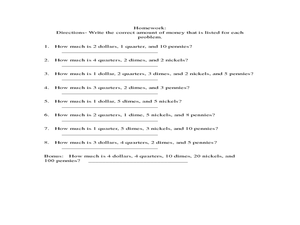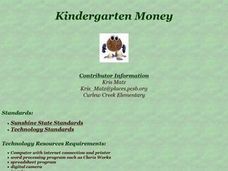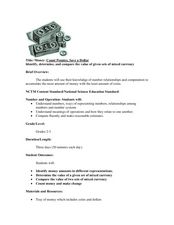Curated OER
Number Value Assessment
Quiz your second graders with this set of math worksheets involving place value, word problems, number sequence, greater than/less than, coin value, expanded form, and much more! Most have multiple choice answers provided, and generally...
Curated OER
Coin Carnival
Students investigate the value of coins. In this coin value lesson, students read The Penny Pot by Stuart Murphy. Students expand on skills learned in the book and engage in activities to determine the value of a mixed set of coins while...
Curated OER
Coins: Names and Value
Students read the story Benny's Pennies and play a matching game where they match the coin to it's value. In this coins lesson plan, students use the SMART Board to view coins.
Curated OER
How Much is that Name?
Learners explore money counting. In this money problem solving lesson, students calculate how much money their name is "worth" using the corresponding alphabet letters which have been assigned a coin value.
Curated OER
Coin Comparison Worksheet
Use this one-page worksheet to assess young learners’ ability to correctly compare a series of coins. Each problem asks counters to indicate with the correct symbol whether the total value of the coins in the left column is greater than,...
Illustrative Mathematics
Jamir's Penny Jar
Before you start counting the coins in Jamir's coin jar, figure out which coin to start with. Should it be the penny or the quarter? Why? This is the focus around a worksheet that works well as an assessment on counting money and...
Illustrative Mathematics
Dimes and Quarters
Here is a coin problem where the algebra learner determines the pair of linear equations needed to solve the system. Whether the equations are taken from a table, or your scholars recognize the format of a coin problem, it is an...
Curated OER
How Much is Saved?
Counting pence is great because some of the common coin values are two, five and ten. Learners assess each piggy bank and count the pence contained within. They count by 2s, 5s, and 10s depending on the coin in each bank. Tip: The...
Curated OER
Money Bags
First graders identify coins and their value. Using a mixed set of pennies, nickels, dimes, and quarters, they sort the coins and identify the name of each coin and the value of one coin in each set. As the teacher announces a given...
Curated OER
Value of Money
Second graders examine a collection of coins to discover their value. In this value of money lesson, 2nd graders identify the amount of money represented by each coin. Students use a worksheet to complete story problems involving...
Curated OER
Money and Business (Art)
Third graders investigate world currency by creating their own coin art. In this government lesson, 3rd graders examine the characteristics of different coins and create their own design for a new one. Students discuss and...
Curated OER
Deena's Lucky Penny
Young scholars discover the coin denominations of U.S. Currency. In this money lesson, students read the book Deena's Lucky Penny, then complete a coin matching activity using the Internet. Young scholars also read Shel...
Curated OER
A Dollar for Penny
Students demonstrate different ways to make a dollar. In this consumer math lesson, students read the book A Dollar for Penny and identify the value of each coin. Students determine combinations of coins that can make up a dollar.
Curated OER
The Random Walk II
Deep mathematical thinking is found with just a coin and a number line. Combining computing some probabilities in a discrete situation, and the interpretation of a function, this simple task gives learners a lot to think about on...
Curated OER
Math/Technology: Coin Combos
Second graders identify coin combinations needed to purchase items under a dollar. Using Kidspiration, they demonstrate three ways to purchase a pizza slice for 96 cents and choose an item which cost less than a dollar for other to...
Curated OER
Decimals: Teaching Decimals in the Hundredths Place
Third graders examine place value in the hundredths place. They use decimals and money for understanding.
Curated OER
All About Money
Few topics engage young mathematicians as much as learning about money. Through a series of shared readings and hands-on activities, children explore the US currency system, learning how to count money and calculate change as they create...
Shodor Education Foundation
Introduction to the Concept of Probability
Acquaint mathematicians to the concept of probability with a discussion about the results of a game. Then have them play a dice, card, spinner, or coin game and recording the number of wins vs. the number of tries on an interactive web...
Curated OER
How Much Money Do You Have?
Second graders are given 8 world problems dealing with an assortment of coins. In this money lesson, 2nd graders determine the answers to each problem with 100% accuracy. Students complete a worksheet that is graded.
Curated OER
Kindergarten Money
Students identify the various coins and their values through presentations, a rubric, a value pretest, and coin manipulatives. Money is incorporated into various activities whether at home or in school. Students create money webs using...
Curated OER
Money
Third graders review the values of quarters, dimes, nickels, and pennies. They discuss how the different types of coins can equal the same amount. Students give examples of ways to make a given amount under $1.00. They explain what the...
Curated OER
The Buffalo War: A Clash of Cultures
Learners view a documentary on the different values and meaning placed on the buffalo. Examining various cultures, they link the attitudes to the treatment of the animal in the wild. They develop solutions to the conflict raised by the...
Curated OER
What's All this Money Madness?
Second graders examine the value of money. In this money lesson, 2nd graders read the book Money Madness by David A. Alder and watch Brain Pop Jr. videos. Students discuss why we need money and how people earn money. Students each...
Curated OER
Money: Count Pennies, Save a Dollar
Students determine how to make the largest sum of money using the least amount of coins. In this mixed currency lesson plan, students listen to a reading of If You Made a Million by David M. Schwartz before participating in money...







